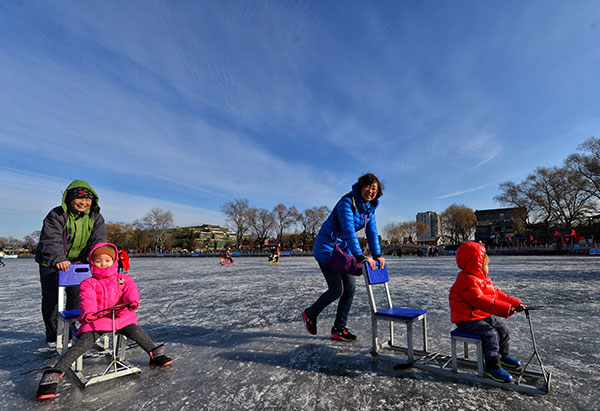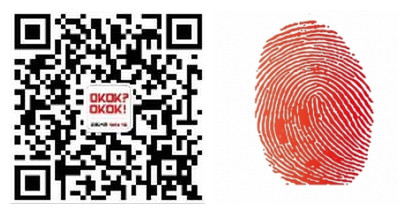 |
|
Visitors play on an ice rink in Shichahai, Beijing, on Monday, when the city enjoyed blue skies and good air. GUO QIAO/CHINA DAILY
|
The national environmental watchdog told the Beijing municipal government on Thursday that it could do better the next time it declared a smog alert.
The first alarm could have been sounded earlier, the Ministry of Environmental Protection said in its review of Beijing's two red alerts for smog in December.
If it had been issued more quickly, it would have better helped residents, the ministry said.
Since November, the Beijing-Tianjin-Hebei region has been engulfed three times by severe smog covering expanses of up to 630,000 square kilometers.
The capital saw the daily average concentration of PM2.5-particles less than 2.5 microns in diameter that are hazardous to health-soar quickly from Nov 15 to Dec 31, reaching a level 75.9 percent higher than the same period of 2015, the ministry said on Thursday.
In response, Beijing issued two red alerts, the highest in the four-level smog alert system. Industrial production was suspended, vehicle use was limited and public schools were closed.
Many residents complained about the red alerts, especially about the school closures-parents worried about their children at home alone while they themselves had to work.
"This was not an effective way to control air pollution, particularly as many people didn't notice the red alert the second time," said Zhang Yiqun, 30, who added that even though he worked for a Chinese media company in Beijing, he received no advance notice of the second red alert, which was in effect from Dec 19 to 22.
Unlike the first red alert-from Dec 8 to 10-over 110,000 vehicles violated the alternating odd-even license plate restrictions during the second alert, the municipal environmental watchdog said.
"I know that the authorities said the air pollution peak was reduced, but I didn't feel the difference. Maybe the improvement wasn't large enough," Zhang said.
Zhang Yanchen, 28, who works at a research institution in the capital, also thought the red alerts had not been effectively controlled and added that the government had to more strictly regulate industrial production and the burning of coal.
On Thursday, the ministry pointed out that from Nov 26 to Dec 1, when Beijing had its heaviest smog of 2015, the capital issued only an orange alert, the second-highest level, bringing measures into effect that were not stringent enough to effectively control the pollution. In addition, though the capital issued the two subsequent red alerts, the first of these did not work well because of the short notice before it took effect, the ministry said.
The second red alert lasted for four days, but the pollution had diminished on the first day, and residents questioned why it had been issued so early.
Wang Bin, head of the Emergency Department of the Beijing Environmental Protection Bureau, said the threshold for red alerts in Beijing had been lowered in March, making them easier to issue than in other provinces and cities, including the neighboring municipality of Tianjin and Hebei province.
The capital has begun soliciting suggestions from experts, as well as from government departments and residents, on how to amend its emergency response system to better serve the public, he said.
The ministry said the Beijing, Tianjin and Hebei regional joint response to air pollution control is proving more effective because of the accumulated experience in the first two rounds.
Offenders pay 183m yuan in fines
Beijing authorities tightened inspections of polluters last year, handing out a record 183 million yuan ($28 million) in fines to companies and individuals who violated regulations.
The fines imposed in the capital rose from 106 million yuan in 2014, the Beijing Environmental Monitoring Team said on Thursday.
Zhong Chonglei, the team leader, said the fines leveled against companies increased by 93.4 percent year-on-year to 156 million yuan, adding that 1,937 cases involving fines of 44 million yuan concerned air pollution.
The capital stepped up inspections last year to cover more than 62,300 companies emitting pollutants.
Limits have been imposed on 19,500 major firms to keep emissions in check.
This year, inspection teams will continue to focus on coal-fired boilers in the first quarter, on polluting industries such as furniture and automobile manufacturing and chemical engineering in the second and third quarters, and on coal consumption in the fourth quarter.
The public played a greater role in helping to combat pollution last year, with the teams receiving 30,014 reports on the environmental protection hotline number of 12369, an increase of 14 percent year-on-year.
All reports on pollution have been completed, Zhong added.
By ZHENG JINRAN (China Daily)
Using WeChat? Scan QR Code or Press the Fingerprint Below ↓
--- (Or ADD WeChat ID: OKOKOKOKnet)
